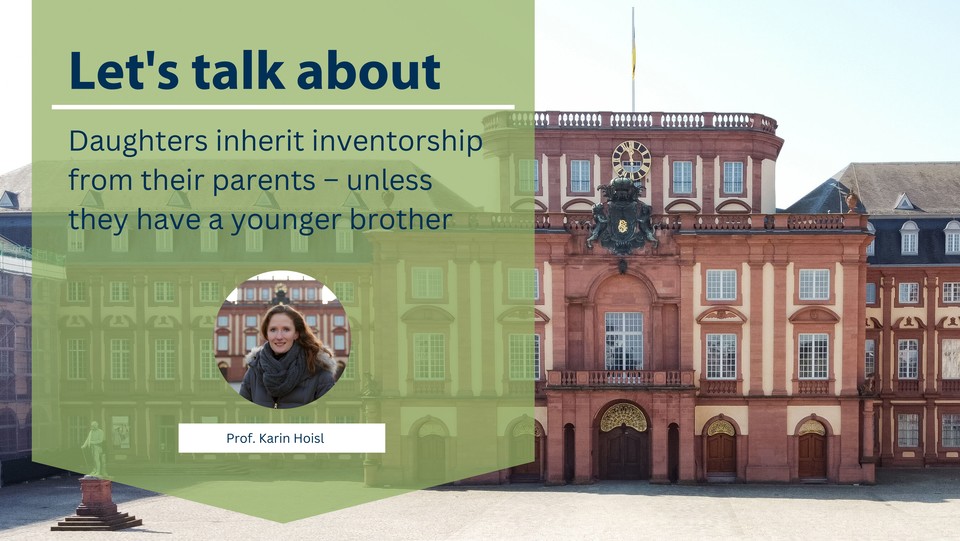Daughters inherit inventorship from their parents – unless they have a younger brother

In recent decades, the gender gap in STEM degrees has gradually narrowed. For example, according to data from the Integrated Postsecondary Education Data System (IPEDS), women represented 45% of students majoring in STEM fields in 2020, up from 40% in 2010.
Also, worldwide statistics show 34% female graduates in STEM fields in 2013. If we look to the US specifically, around 48% of graduates in STEM are women, based on data from ILOSTAT.
However, despite this progression, patented inventions still overwhelmingly come from men: female inventors comprise around 17% of the global inventor population, according to World Intellectual Property Organization data from 2021. In some countries, such as Japan, female inventors are as low as 10% of the inventor population.
If we acknowledge that talent and creativity are equally distributed between genders, the potential for girls to grow up to become inventors must be getting lost along the way.
Therefore, alongside colleagues Hans Chrsitain Kongsted from Copenhagen Business School and Myriam Mariani from Bocconi University, we investigated the role of parental inventorship on inventorship in children.
Using data from almost 1.2million Danish children born between 1966 and 1985, we established whether one, both, or neither parent of the children were inventors, and whether the children themselves became inventors. We identified inventors as those listed on at least one European patent application. Just to note, as further evidence that female inventor potential is getting lost, only 15% of inventors from our sample were women.
From our findings, we established that having parents who were inventors increased the probability of first-born daughters also becoming inventors, but only if they did not have a second-born brother. The presence of a younger brother limits the extent to which an older sister benefits from parental knowledge and skills, discussion of career plans, access to parental networks, or transmission of enthusiasm for creativity and innovativeness.
In addition to this, first-born sons were also found to inherit inventorship from parents but are not negatively impacted by the presence of a subsequent sibling. The transmission of inventorship to a first-born daughter is also unaffected if they have a second-born sister.
This demonstrates that gender plays a strong role in how parental inventorship is transmitted to children. It also suggests that this crowding-out effect for first-born daughters is not simply due to sharing resources among more children, but does depend on gender, made evident by the arrival of a second-born brother to a first-born girl.
Parents seem to be intermediaries who form gendered expectations on whether their daughters and sons will find success as inventors, based on their interpretation of inventive jobs. These expectations cause them create or limit opportunities for their children and allocate their time and resources differently based on gender.
From our research, it appears behaviours that create gendered career or profession choices for children begin early, develop with the family, and influence children’s opportunities through routes other than education. Therefore, pushing more women into STEM graduate degrees could help, but it might not be enough to eliminate the gender gap in inventorship or impact inventor demographics.
Role models alone cannot close the gap for new generations either: they can strongly influence educational choices, but not the transmission of parental inventorship.
As behaviours which lead to gendered career or profession choices are linked to childhood, to decrease the gender gap in inventorship, we should intervene in these early years, targeting both the children and the parents. An important first step is ensuring people are aware of stereotypical thinking and gendered behaviours that can limit children’s opportunities.
Another effective tool to increase awareness is disseminating information about successful women in male-dominated jobs; STEM-related jobs in particular. Reports on women’s careers in science and technology, examples of successful female researchers, and the role of the environment in shaping decisions can be useful.
Because parents develop their interpretations based on external information they interpret, interventions should also be directed to change the context that generated this information. Therefore, any action that increases the number of women in science and technology and improves their treatment and visibility would be beneficial for how women are perceived in STEM-related and inventive roles.
Professor Dr. Karin Hoisl, holder of the Chair of Organisation and Innovation at the University of Mannheim Business School.